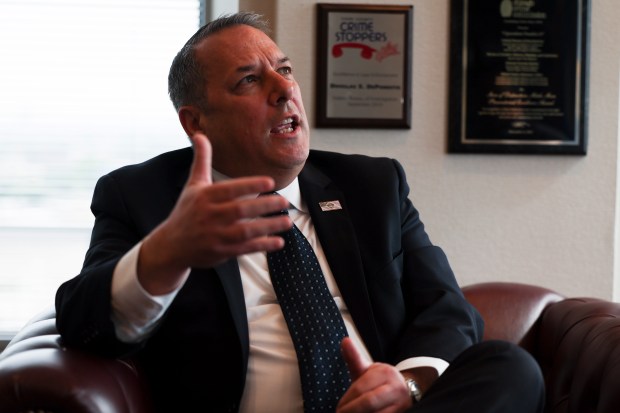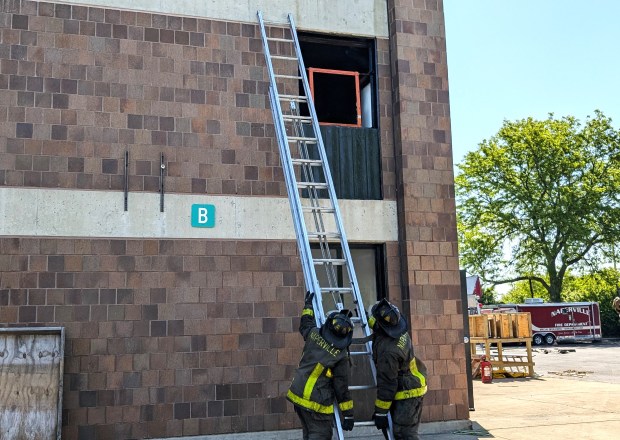We’re a little more than a week out from the NFL draft, and the Chicago Bears — with four picks in the top 72 — are finalizing preparations.
Intrigue surrounds what the Bears will do in the first round, with a number of positions and prospects looking like options at No. 10. Brad Biggs dives deep into the possibilities in his weekly Bears mailbag.
- NFL mock draft 2.0: Who will the Chicago Bears select with the No. 10 pick?
- Sign up for Bears Insider for everything you need to know in one easy-to-read newsletter
If all of the commonly mocked players to the Bears (Will Campbell, Ashton Jeanty, Tyler Warren, Armand Membou) are gone at pick 10, where could you see them leaning at that point? — @windycityflyer
That is a great question and might be the key to unraveling the mystery of whom general manager Ryan Poles and the Bears eventually end up with in the first round. I wish I had a similarly great answer for you because that would give me some degree of confidence in determining how things could unfold on draft night.
In this scenario, with the marquee prospects off the board (and I’m not convinced Membou, the right tackle from Missouri, belongs in that group), the Bears would have to make a decision: pick based on need, which could lead them toward a player who can compete for the left tackle job, or go with the highest-graded player on their board.
The way this draft shapes up, with depth into the second and maybe even the third round, I’ve shifted my thinking a little bit. I think it’s imperative Poles gets the best possible player at No. 10, no matter the position, and then sorts through the possibilities and needs beginning on Day 2 to find matches that make sense. I say that because two years from now, you won’t look back on the 2025 draft and ask if the Bears filled a need with their top pick. You’ll ask if they got a good player who is contributing to on-field success.
If you’re of the mindset that left tackle is the team’s greatest need — and the draft grade for left tackle options at No. 10 is surpassed by grades of players at different positions — there’s a chance some options might be available in Round 2. The range for Ohio State’s Josh Simmons is all over the board. I’m not certain he’s assured of being chosen in the first round, although that’s probably likelier than not. Oregon’s Josh Conerly could be available early in Round 2. I’ve chatted with one scout who compares Minnesota’s Aireontae Ersery favorably to Membou.
That brings us back to this question: OK, what’s the plan at No. 10 if it’s not an offensive tackle? First, I would want to investigate edge rushers. Let’s assume Georgia’s Jalon Walker is off the board. How do the Bears feel about his teammate Mykel Williams or Texas A&M’s Shemar Stewart? What’s the assessment of cornerbacks Will Johnson and Jahdae Barron? Is it too early for a versatile safety like Nick Emmanwori or Malaki Starks?
NFL mock draft 2.0: Who will the Chicago Bears select with the No. 10 pick?
What kind of grade do they have on tight end Colston Loveland? Could there be a plan for linebacker Jihaad Campbell? In a deep draft for running backs, is it too early for RB2 after Jeanty? A year after choosing Rome Odunze with the ninth pick, is it too soon to consider a wide receiver? What about DT2 after Mason Graham?
Start digging deep and we can put together a pool of a dozen players to at least wonder about. Like I said, I really wish I had a firm answer I could provide with conviction. At this juncture, it’s possible Poles and his staff, along with coach Ben Johnson, still are working their way through this maze. What to do at No. 10? I think the answer will come down to the player they believe has the brightest future, regardless of position, and then they can start narrowing the focus to needs on Day 2.
Is it possible that Missouri right tackle Armand Membou could emerge as a left tackle for the Bears if selected at No. 10? — Al C., Clarendon Hills
Based on what I’ve heard, Membou is likelier to wind up playing guard in the NFL than left tackle. My hunch is if a team chooses him in the top half of Round 1, it would be with the idea of playing him at right tackle first, unless that team is set at that position.
Membou measured 6-foot-4 and 332 pounds at the scouting combine, and generally speaking that’s a little short for an offensive tackle — on either side. He has 33½-inch arms, which is adequate for the position, and he tested very well athletically.
I can tell you that early in the college season, some NFL teams were looking at him as a guard at the next level. I think teams are a little more open-minded now, but opinions of Membou vary. One national scout I chatted with last week said Membou is pretty raw and there’s some boom or bust to drafting him high in Round 1. He noted the upside and athleticism but said he saw considerable inconsistency both in person and on the tape he evaluated.
Sometimes college teams are telling you a player can’t play left tackle in the NFL based on where he plays in college. That’s not always the case, especially in the NIL and transfer portal era when you have a lot of player movement. If a team has a left tackle in place and adds a potential left tackle, sometimes it will leave the incumbent in place so he doesn’t have to learn a new position and play the newcomer at right tackle.
But if a player is playing strictly right tackle for a number of seasons, that also can mean the college staff has deemed him not suitable for the left side. Just something to keep in mind when wondering about college right tackles playing on the left side on Sundays.
With Shemar Stewart making a predraft visit to the Bears, is he a legitimate candidate to be the pick at No. 10? — Craig D., Elmhurst
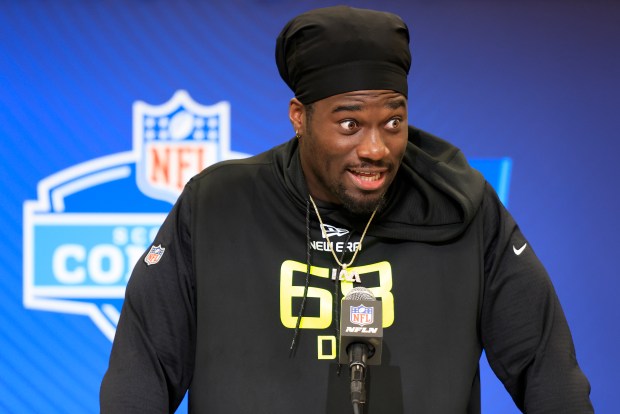
If Stewart had more production in college to match his immense physical skills, there would be serious discussion about him being a top-five pick. He dominated at the scouting combine, where he measured 6-5 and 267 pounds with 34 1/8-inch arms. He ran the 40-yard dash in 4.59 seconds, and his 10-yard split of 1.58 seconds was particularly impressive. Add a 40-inch vertical jump and a broad jump of 10 feet, 11 inches, and it stands to reason the Bears wanted to learn more about Stewart with the draft a little more than a week away.
Stewart played 37 games in three seasons at Texas A&M with 19 starts (12 coming last season) and totaled only 4½ sacks. In 2024 he had 5½ tackles for a loss, 1½ sacks and two pass breakups.
The question the Bears and other teams will have to answer is whether they believe Stewart, with their coaching, can become a more consistent player. He needs to play with better technique to disengage blockers. He needs to improve his awareness and play recognition. And he needs to finish more regularly with his speed, strength and quickness.
I think No. 10 is a little rich for Stewart, but it takes only one team to fall in love with the measurables and talk itself into the idea it can develop him into a star edge rusher.
If Ashton Jeanty is gone before No. 10 and all the blue chippers are off the board, would it be too early to take Omarion Hampton? The Lions did it with Jahmyr Gibbs. My argument is if all the blue chips are off the board and lots of the good talent is in the middle of this draft, why not take a guy who is going to immediately help your team instead of a guy who might come off the bench and not start? — @bears_dubz
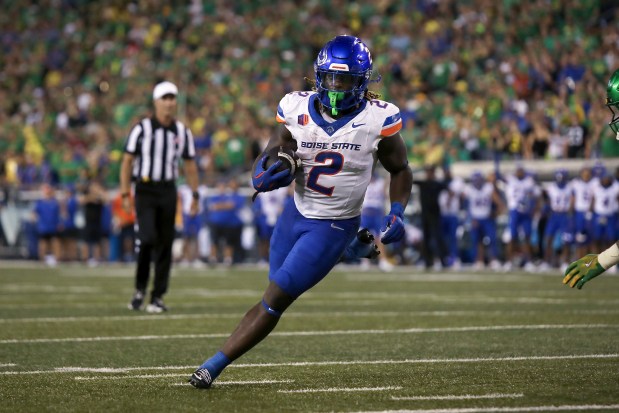
If the Bears view Hampton as a potentially elite running back who can anchor the backfield for the next five seasons, it’s not too early to select him. One hole I can poke in your argument — and it’s a significant one — is that the Lions drafted Gibbs with the 12th pick in 2023 after substantially building their offensive line and adding some big pieces to the defense. In other words, Gibbs was sort of the final piece for an emerging offense that was developed from the inside out.
I think too much attention has been paid to what the Lions did in the draft the last several years. Did Ben Johnson have input into what they did? Sure. Coordinators are involved in the predraft process, but it’s a minor role in the grand scheme.
After choosing Gibbs in 2023, the Lions added linebacker Jack Campbell in the first round and tight end Sam LaPorta and safety Brian Branch in Round 2. What stands out about their drafts the last several years is how they found a lot of talent on the second and third days. Since 2020, their third-round picks include guard Jonah Jackson — now with the Bears — defensive tackle Alim McNeill and safety Kerby Joseph. Fourth-round picks include wide receiver Amon-Ra St. Brown and linebacker Derrick Barnes.
It’s the depth of the drafts under general manager Brad Holmes that has helped the Lions become a force in the NFC, not just some solid first-round picks, including an unconventional one in Gibbs. Remember, the Lions were roundly criticized at the time for choosing a running back that high.
If Jeanty somehow makes it to No. 10 — and it sounds as if the chances of that happening are slim — the Bears could get a special player in a strong draft for running backs. If Jeanty is off the board, I think the chances are greater the Bears would be willing to wait until the second round, when they have two picks, or the third to scoop up a running back.
It’s possible the team is doing extended homework on Hampton in the event Ryan Poles can swing a trade down in Round 1. But if there’s strong conviction on Hampton’s ability to be a major cog in the offense, you could justify the pick.
I see a lot of people saying Bears should pick a defensive tackle at some point, but I think they go five deep there. Isn’t edge the more important position to attack in this year’s draft? — Rick C., Lemont
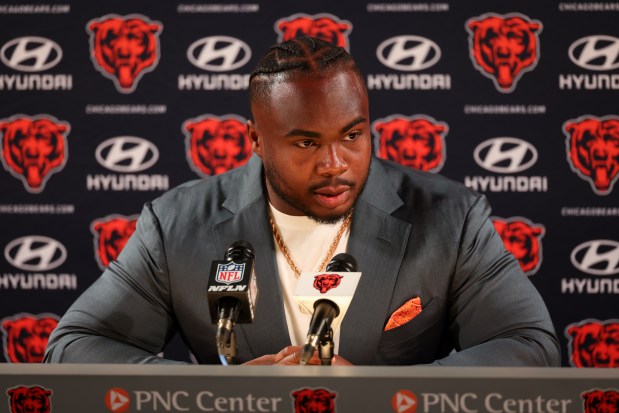
You could make a case that the Bears are six deep at defensive tackle. I think the scope you’re using to evaluate needs or wants is too limited. Yes, you consider immediate needs and what the depth chart looks like now, but the overarching conversation has to focus on what kind of impact players in this draft class can have in 2026, 2027 and beyond. General managers are looking two, three years out for players who can compete for playing time and contribute in the future — not just this September and October.
Taking a broader view, and understanding it’s a very good class for defensive tackles, it makes a lot of sense to consider adding a player at that position. Grady Jarrett, who turns 32 this month, signed a three-year contract and is preparing for his 11th season. He’ll have to remain remarkably productive and healthy for his age to be in the mix in 2027. Andrew Billings is entering a contract year, and Chris Williams also will be an unrestricted free agent after this season.
Jonathan Ford is kind of a wild card, a big body in the middle who was an interesting signing off the Green Bay Packers practice squad late last season. Then you have Gervon Dexter and Zacch Pickens entering their third season. When you take a step back and look at this position in 2026 and 2027, you can make a strong case for adding a player there whom you like.
Yes, you can do the same exercise at defensive end, and I’ve been pretty consistent that the Bears need another edge rusher if they’re going to improve their pass rush. I don’t view this as an either/or. I think the Bears, if the board falls the right way, need to get both an edge rusher and a tackle in this class.
What three positions do you see as the Bears’ biggest needs in this year’s draft? — Gerry, Rochester, N.Y.
As I conveyed above, it’s problematic to view a draft through the lens of immediate roster needs because when teams get caught drafting for need, they often err in bypassing more talented players.
That being said, if you’re strictly looking at the current depth chart and the needs for 2025, I’d say left tackle, edge rusher and running back, with safety also in the mix. Defensive tackle, tight end, linebacker and guard loom as wants, and you never should discount the possibility of adding a cornerback. If there’s a wide receiver Ben Johnson views as an ideal fit for his scheme — perhaps one with top-end speed — that would also make a lot of sense.
In other words, the Bears can go in a lot of directions with the goal of increasing competition and improving the roster.
With the scouting combine and pro days all done, is the Bears’ draft board/player rankings complete? If not, why not? I imagine they’ve watched all the tape they need to by now. Would a few more in-person player visits really change much? I’m curious how teams handle these last few weeks (before the) draft. GMs always say they drafted the highest player on their board. If so, why make more adjustments in these last two weeks when the tape and combine results are in? — Tim L., Lisle

Some good questions in there. My first reaction is that teams, the Bears included, want to maximize all of the time available to them in the predraft process to be as meticulous as possible. Medical information can come in late in the process that can significantly alter draft grades. That’s probably the only thing that really would move a player on a board at this point.
I chatted with a national scout for another team earlier this week as his team was preparing to launch into a full week of meetings before taking this weekend off and reconvening next week. He said this week can involve very detailed conversations about certain positions or players. For instance, CB5 can become CB4 and WR8 can become WR5. He said the discussions can hinge on a player’s production versus his traits and ability to improve. What does the player look like now? What will he look like in 2027? Those are the kinds of debates that can lead teams to tweak their draft boards.
If the Bears were to give up their third-round pick, how far do you expect they could move up? I know they must first find a willing trader. — Jerry L., Chicago
If the Bears were to bundle the 10th pick with their third-round choice at No. 72, the highest they could get would be No. 7, and that’s only if the New York Jets were willing to move. Sometimes teams put a little more weight on top-10 picks and demand more in return.
The Bears would have to be supremely motivated to trade up in this draft. They have a solid collection of draft capital with two second-round picks plus the third-rounder that’s in the top third of that round. Start bundling picks to move up, and all of a sudden you’re drafting fewer players. From my viewpoint, the Bears need a collection of young players to add to the mix.
What teams would be willing to trade up to No. 10 and why? — @enefel_football
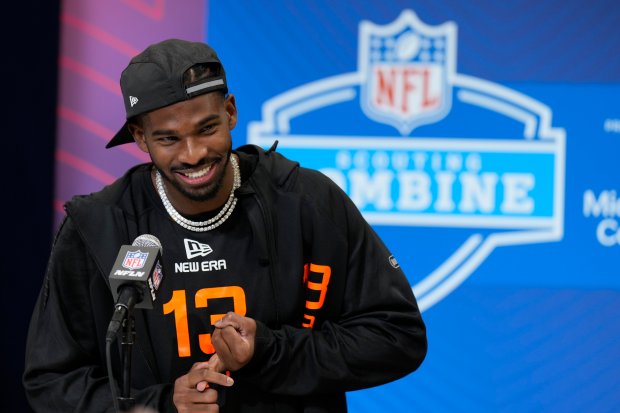
That’s hard to say. The New Orleans Saints could be motivated to get a quarterback with Derek Carr’s 2025 season reportedly in question because of a shoulder injury. They have Spencer Rattler, Jake Haener and Ben DiNucci on the depth chart behind Carr, so the Saints are a team to watch for Colorado’s Shedeur Sanders or maybe even Mississippi’s Jaxson Dart. But they’re picking at No. 9 — ahead of the Bears — so any team looking to get ahead of the Saints for a quarterback also would have to jump ahead of the Bears.
It’s certainly unusual that, as things stand, every team owns its original first-round pick. You have to figure there will be a handful of trades, and if the scenario is right, I believe Ryan Poles would be open to moving down in Round 1.
What would drive a team to move up? Maybe a team hunting a cornerback if it fears its target won’t be on the board long. The San Francisco 49ers pick right behind the Bears at No. 11 and have needs at corner and on both lines. Perhaps a trade partner emerges that desires to get ahead of the 49ers. This could be a prime area for a cornerback. Colorado’s Travis Hunter will be long gone, but folks I talk to like him much more as a wide receiver. So you could be talking about a range for the first true cornerback to be selected.
If Penn State tight end Tyler Warren is on the board at No. 10, he could generate trade interest. But he also might be too good for the Bears to pass on him.
Is a trade back in the second round more realistic than a trade back in the first? — @greatnxss_
That seems likelier for a number of reasons. There might not be keen interest in the No. 10 pick. It could be a situation where a handful of teams in that range, the Bears included, are more interested in dealing back than moving up. Of course, there are more chances for a trade down in Round 2 with the Bears owning two picks at Nos. 39 and 41, the first coming via the Carolina Panthers.
But we don’t know any of the factors that would be involved. How far down would the Bears be asked to move? What would the package include? What pool of players could be available? What has the team already added in the draft? Way too many variables to say, “Yeah, this is likely.” Something to be open-minded about, though, for sure.




